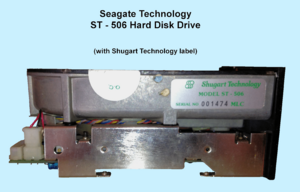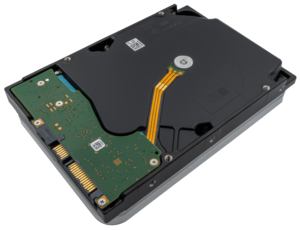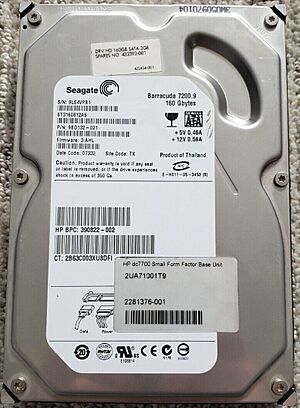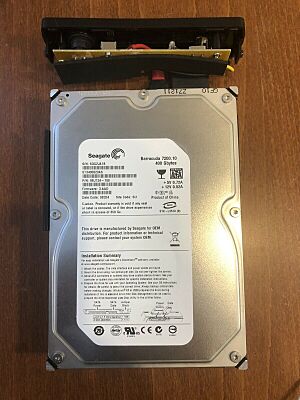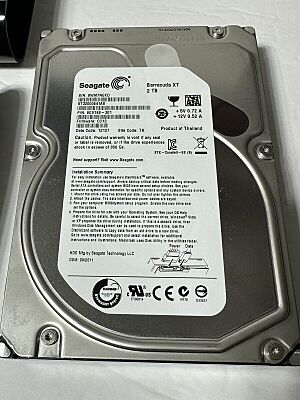Seagate Technology facts for kids
 |
|
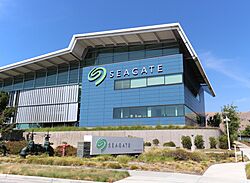
Operational headquarters in Fremont, California
|
|
| Public | |
| Traded as | |
| Industry | Computer storage |
| Predecessor | Shugart Technology |
| Founded | November 1, 1979 (as Shugart Technology) |
| Founders |
|
| Headquarters | Fremont, California, United States (operational) Dublin, Ireland (legal domicile) |
|
Area served
|
Worldwide |
|
Key people
|
Michael R. Cannon (chairman) Dave Mosley (CEO) |
| Products | |
| Revenue | |
|
Operating income
|
|
| Total assets | |
| Total equity | ▲ −US$453 million (2025) |
|
Number of employees
|
30,000 (2025) |
| Subsidiaries | LaCie |
| Footnotes / references Financials as of June 27, 2025[update]. |
|
Seagate Technology Holdings plc is a company from America that makes things to store computer information. It started in 1978 as Shugart Technology and began working in 1979. Since 2010, its main legal office has been in Dublin, Ireland. Its main working office is in Fremont, California, United States.
In 1980, Seagate made the very first 5.25-inch hard disk drive (HDD). It was called the ST-506 and could hold 5 megabytes of data. They became a big supplier for small computers in the 1980s. This was especially true after the IBM XT computer came out in 1983. Seagate grew a lot by buying other companies. They bought Control Data Corporation's Imprimis division in 1989. Then they bought Conner Peripherals in 1996, Maxtor in 2006, and Samsung's HDD business in 2011. Today, Seagate and its main competitor, Western Digital, are the top companies in the HDD market.
History of Seagate
How Seagate Started
Seagate Technology first started on November 1, 1978. It was called Shugart Technology back then. The company began its work in October 1979. Its founders were Al Shugart, Tom Mitchell, Doug Mahon, Finis Conner, and Syed Iftikar.
The idea for the company came when Finis Conner talked to Al Shugart. Conner believed that 5.25-inch hard drives would become very popular. So, they decided to start a new company to make them. The company's name was later changed to Seagate Technology. This was to avoid problems with Xerox's company, Shugart Associates, which Al Shugart had also founded.
Early Years and Growth
Seagate's first product was the ST-506 hard drive, released in 1980. It could store 5 megabytes (MB) of data. This was the first hard drive that fit the 5.25-inch size, like the floppy disk drives of that time. The next year, they released a 10 MB version called the ST-412.
With these drives, Seagate got a big contract with IBM. They became a main supplier for the IBM XT, which was IBM's first personal computer with a hard drive. Selling many units to IBM helped Seagate grow quickly. In their first year, Seagate sold $10 million worth of products. By 1983, they had sold over 200,000 units, bringing in $110 million.
In 1983, Tom Mitchell became the new president, replacing Al Shugart. This change helped the company adjust to the changing market. At this time, Seagate had 45% of the market for hard drives used by single users. IBM bought 60% of all the products Seagate made.
In 1989, Seagate bought Imprimis Technology. This was the disk storage part of Control Data Corporation. This purchase made Seagate's market share reach 43%. Seagate gained from Imprimis' advanced technology. Imprimis, in turn, got access to Seagate's lower costs for parts and manufacturing.
Leadership Changes in the 1990s
In September 1991, Tom Mitchell left his role as president. Al Shugart became president again. Shugart decided to focus the company on its more profitable markets. He also focused on drives for larger computer systems instead of external drives. He stopped sending component production overseas. This helped Seagate keep up with the very fast increase in demand for PCs in 1993.
In 1991, Seagate also introduced the Barracuda HDD. This was the first hard drive in the industry with a 7,200 RPM (revolutions per minute) spinning speed.
By May 1993, Seagate was the first company to have shipped a total of 50 million hard drives. The next year, Seagate Technology Inc. moved its stock listing from the Nasdaq to the New York Stock Exchange. In 1996, Seagate joined with Conner Peripherals. This made them the world's largest independent maker of hard drives. After this, the company started to combine its parts and production methods. This helped make products more efficiently across its factories.
In 1996, Seagate introduced the Cheetah 4LP. This was the industry's first hard drive with a 10,000 RPM spinning speed. By 2000, this product reached a speed of 15,000 RPM with the Cheetah 15X. In May 1997, a court in England made Seagate pay Amstrad PLC $93 million. This was for hard drives Seagate sold to Amstrad that were said to be faulty. That year, Seagate also introduced the first Fibre Channel interface hard drive.
In 1997, Seagate, like the rest of the industry, faced a difficult time. In July 1998, Al Shugart left his positions with the company. Stephen J. "Steve" Luczo became the new chief executive officer. He also joined the board of directors.
Steve Luczo's First Time as CEO (1998–2004)
Steve Luczo joined Seagate Technology in October 1993. He became Senior Vice President of Corporate Development. In March 1995, he was made Executive Vice President of Corporate Development. He also became chief operating officer of Seagate Software Holdings. In 1996, Luczo led Seagate's purchase of Conner Peripherals. This made Seagate the world's largest maker of disk drives. It also helped the company control more of its own parts. In September 1997, he was promoted to President and Chief Operating Officer.
In 1998, the board chose Luczo as the new CEO. Seagate then started a big reorganization. Before, Seagate's design teams were organized by their job. One manager tracked all projects. In 1998, Luczo and CTO Tom Porter changed this. They organized design teams into smaller groups focused on single projects. This helped the company get products to market faster.
As CEO, Luczo decided to invest more in new technology. He also wanted to expand into faster-growing businesses that made more money. He chose to use a highly automated system for manufacturing. Between 1997 and 2004, Seagate reduced its number of employees from about 111,000 to 50,000. It also cut its factories from 24 to 11 and design centers from seven to three. During this time, Seagate's production increased. It went from about 9 million drives per quarter to about 20 million drives per quarter.
In 1998, the Seagate Research facility was also created in Pittsburgh. This was a $30 million investment. It focused on future technologies and new product ideas. One technology developed there was the hard drive for Microsoft's first Xbox game console. In 1999, Seagate shipped its 250 millionth hard drive.
In May 1999, Seagate sold its Network & Storage Management Group (NSMG) to Veritas Software. In return, Seagate received 155 million shares of Veritas' stock. This made Seagate the biggest shareholder in Veritas, owning over 40% of the company.
Becoming a Private Company (2000)
In 2000, Seagate became a private company again. Luczo led a deal for the company's management to buy Seagate. He believed Seagate needed to invest a lot of money to reach its goals. He decided to make the company private because disk drive makers often found it hard to get money for long-term projects. The company was set up in Grand Cayman and stayed private until it became public again in 2002.
In November 1999, Luczo met with people from Silver Lake Partners. They talked about a big change for Seagate. On November 22, 2000, Seagate management, Veritas Software, and a group of investors led by Silver Lake completed a complex deal. This deal made Seagate a private company. At the time, it was the largest buyout ever for a technology company. The total deal was worth about $20 billion. It included selling its disk-drive operations for $2 billion to the investor group.
After moving its legal base to the Cayman Islands in 2000, the main company's name was shortened to Seagate Technology. The company that actually did the work, set up in Delaware, became a limited liability company (LLC) called Seagate Technology LLC. It still operates this way today.
Becoming a Public Company Again (2002–2010)
Luczo became the chairman of Seagate Technology's board of directors on June 19, 2002. In 2003, he was invited to join the New York Stock Exchange's advisory committee for listed companies.
In 2003, Seagate started making hard drives for notebook computers again. They also provided the 1-inch hard drives for the first iPods. This led to a trend where digital devices had more and more memory, especially cameras and music players. In September 2004, The New York Times called Seagate "the nation's top maker of hard drives used to store data in computers." This was after the company predicted its quarterly earnings would be higher than expected.
In 2004, the company separated the jobs of chairman and CEO. Luczo resigned as CEO on July 3, but he stayed as chairman of the board. Bill Watkins became the new CEO.
In early 2006, Forbes magazine named Seagate its Company of the Year. They called it the best-managed company in the United States. Forbes said that "Seagate is benefiting from the world's gadget boom." It also said that Seagate's 1-inch drives were used in cameras and MP3 players. The magazine also gave Seagate credit for starting the personal computer revolution 25 years earlier with the first 5.25-inch hard drive for PCs.
In April 2006, Seagate announced the first professional camera that recorded directly to a disk. This camera was for independent filmmakers and used Seagate's hard drives. In 2007, Seagate created the idea of a hybrid drive. In April 2008, Seagate was the first company to ship one billion hard drives. According to CNET, it took 17 years to ship the first 100 million. It took only 15 more years to ship the next 900 million. In 2009, Bill Watkins left his job as CEO.
On August 27, 2008, Seagate's stock moved to the NASDAQ Global Select Market. It continued to trade under the same symbol, STX.
Steve Luczo's Second Time as CEO (2009–2017)
In January 2009, the Seagate Board asked Luczo to come back as CEO. He replaced Bill Watkins. When he returned, Seagate was losing market share. Its income was falling fast, and it had high manufacturing costs. The company also had $2 billion in debt that was due soon. Its market value was less than $1.5 billion.
Luczo changed the entire management team. He quickly reorganized the company back to a functional structure. By the end of 2009, the company had reorganized its debt and started to improve its operations. In 2010, Seagate started paying dividends again and began buying back its own stock.
In 2010, Seagate announced it was moving its headquarters and most of its staff from Scotts Valley to Cupertino, California. In June 2010, Seagate released the world's first 3 TB hard drive. That September, Seagate released the first portable 1.5 TB hard drive.
In July 2011, the company changed its country of incorporation from the Cayman Islands to Ireland. Since then, the main company became a public limited company (PLC) called Seagate Technology plc.
In December 2011, Seagate bought Samsung's hard drive business. Seagate also got a license to use the Samsung brand name on hard drive products for 5 years. After the license ended, Seagate renamed all Samsung-branded external hard drives to Maxtor. Maxtor was a company Seagate had bought in late 2005. After the purchase, internal hard drives from former Samsung factories were first branded as both Samsung and Seagate. Later, they were only branded as Seagate.
In 2012, Seagate continued to increase its dividend and bought back almost 30% of the company's shares. In the financial year ending June 2012, Seagate had record income, profits, and gross margins. It also became the largest disk drive maker again. Its market value had grown to over $14 billion. In March 2012, Seagate showed the first 1 TB per square inch density hard drive. They said it could possibly reach 60 TB by 2030.
In 2013, Seagate was the first hard drive company to start shipping shingled magnetic recording drives. In September, they announced they had already shipped over 1 million such drives. In August 2016, Seagate showed its 60 TB SSD. They claimed it was "the largest SSD ever shown." This happened at the Flash Memory Summit in Santa Clara.
In January 2017, Seagate announced it was closing one of its largest hard drive assembly plants. This plant was in Suzhou, China. The plant became part of Seagate after the Maxtor purchase in 2006. Maxtor had started making hard drives in Suzhou in 2004.
Dave Mosley Era (2017–Present)
On July 25, 2017, David "Dave" Mosley was chosen as the new CEO. He started on October 1, 2017. This happened after long-time CEO Steve Luczo stepped down. Luczo became executive chairman.
In June 2018, Seagate was honored at the 14th Annual Manufacturing Leadership Awards Gala. In 2018, Seagate invested in Ripple, a company that uses blockchain technology for businesses. In 2019, Seagate invested £47 million in a research and development project at its factory in Derry, Northern Ireland.
In 2020, Seagate announced it was moving its headquarters and most of its staff from Cupertino to Fremont, California. From May to June that year, the company let go of 500 employees in 12 countries. This was to make operations more efficient. Seagate planned to rearrange more resources, including combining facilities in Minnesota.
In September 2020, Seagate announced it was entering the object storage business. It introduced CORTX, which is open-source software for object storage. It also introduced Lyve Rack, a design based on CORTX. And it created a community for developers. This community is a group of open-source researchers and developers. They work to improve large-capacity object storage. The CORTX open-source software is available for download and collaboration on GitHub.
As of May 18, 2021, the new Irish public limited company Seagate Technology Holdings plc became the main public company for Seagate. It replaced "Seagate Technology plc."
In November 2021, Seagate showed the first hard drive with a non-volatile memory express (NVMe) interface. This was at the Open Compute Summit. This was unusual because hard drives usually operate much slower than what the NVMe interface is designed for. NVMe is typically used with faster storage like SSDs.
In May 2022, Seagate showed its LiDAR system at a conference in Detroit. In February 2023, it sold its LiDAR division to Luminar Technologies. In October 2022, Seagate announced a plan to reduce its number of employees by 8%. This meant about 3,000 jobs.
On January 17, 2024, Seagate announced the release of the first 30 TB HDD. This was part of the Exos Mozaic 3+ HDD series. This series uses Heat-Assisted Magnetic Recording (HAMR) and Shingled Magnetic Recording (SMR) technology. It has an areal density of 3 TB per platter. The 30 TB Mozaic 3+ drive uses ten platters. This is only one more than the 16 TB Exos X16. Seagate plans to increase the capacity of its HAMR drives. They aim to reach an areal density of 5 TB per platter by 2028. Seagate says the new drives will cost less per TB compared to older models. The series was first only for businesses. It became available to regular users by mid-July 2025.
In February 2025, Seagate announced it would buy Intevac. Intevac is a company that makes equipment for HDDs. The deal was for $119 million in cash.
Seagate Products
Internal Storage: SSDs and HDDs
Seagate makes different kinds of internal solid-state drive (SSD) and hard disk drive (HDD) products. They are named for how they are meant to be used:
- Barracuda – These are Seagate's most popular and affordable SSDs and HDDs. They are for general use in devices like computers, laptops, gaming consoles, and set-top boxes. Barracuda HDDs have speeds of 5,200–7,200 RPM. They can store from 500 GB to 8 TB. Their maximum speed is up to 190 MB/s. Barracuda SSDs come with either SATA or NVMe connections. They have storage sizes from 240 GB to 2 TB. Read speeds are up to 560 MB/s for SATA and 3,400 MB/s for NVMe.
- Firecuda – These are for gaming in computers, laptops, and gaming consoles. Seagate offers internal and external Firecuda SSDs and HDDs. They use SATA, NVMe, or USB-C connections. Storage capacity ranges from 250 GB to 16 TB.
- Ironwolf – These are storage drives for NAS devices. Ironwolf HDDs have storage capacities of 1–20 TB. They can be regular or helium-filled drives. They use a SATA connection and have speeds up to 260 MB/s. Ironwolf SSDs have capacities of 240 GB to 4 TB. They use SATA or NVMe connections. Speeds are up to 560 MB/s for SATA and 3,150 MB/s for NVMe.
- Skyhawk – These are recording drives for surveillance systems. They are used in devices like DVRs or NVRs. There are two series. The Skyhawk AI series has capacities of 8–18 TB. They are regular or helium-filled drives. They use CMR recording technology and have speeds up to 260 MB/s. The regular Skyhawk series has capacities of 1–8 TB. They are regular drives. They use CMR or SMR recording technology and have speeds up to 210 MB/s.
- Exos – These are drives for large data centers. There are three series:
- Exos E – Capacities of 300 GB to 8 TB. They use SAS or SATA connections. Speeds are up to 300 MB/s.
- Exos X – Capacities of 12–20 TB. They are helium-filled drives. They use SAS or SATA connections. Speeds are up to 524 MB/s on some models.
- Exos Mozaic 3+ – These have 30TB+ capacity. They have a 7200 RPM spinning speed and 512 MB cache. They were introduced in 2023 with less storage as Exos X. Mozaic 3+ will be sold to businesses and also to regular users. No special hardware is needed to read them.
- Nytro – This series includes enterprise Serial Attached SCSI Solid State Drives. They have capacities up to 15 TB.
External Storage: SSDs and HDDs
Seagate offers many external storage products for computers and laptops:
- Seagate Basic External HDDs
- Backup Plus External HDDs
- Backup Plus Hub External HDDs
- Photo Drive External HDDs
- Barracuda Fast External SSDs
- Seagate Expansion External SSD and HDDs
- One Touch External SSD and HDDs
- Ultra Touch External SSD and HDDs
Gaming Console Storage
Seagate has worked with both PlayStation and Xbox. They offer various storage devices for the PlayStation 4, Xbox One, and Xbox Series X/S. For the PlayStation 4 and Xbox One Series, Seagate offers the "Game Drive." This is a 2–4 TB USB 3.0 external hard drive. For the Xbox One series, Seagate also offers a "New Game Drive" in capacities of 2–5 TB. There is also a "Game Drive Hub" with a capacity up to 8 TB. Both of these also use the USB 3.0 connection.
When the new Xbox Series X/S was being made, Seagate partnered with Xbox. They created a special SSD expansion card. This card plugs into the back of the console. It is available in a 1 TB capacity, with 2 TB planned for later.
Lyve Cloud Storage
Lyve Cloud is a storage service based in the cloud. Seagate first offered it in February 2021. It was made with Equinix and is for businesses.
Data Storage Systems
Seagate offers different data storage systems for businesses. These include "compute & storage convergence platforms" and flash, hybrid, and disk arrays.
In June 2021, Seagate introduced the Exos CORVAULT. This is a 4U block storage system. It has two storage controllers powered by Seagate's own VelosCT chip. The storage system uses Advanced Distributed Autonomic Protection Technology (ADAPT) and Autonomous Drive Regeneration (ADR). These technologies help automate maintenance and reduce electronic waste.
Older Product Lines
Some of Seagate's old product lines are no longer made:
- U-Series – These were cheaper desktop HDDs with lower performance. They were introduced in the late 1990s.
- Medalist – A line of common HDDs for desktops and more. This was later replaced by the Barracuda series.
- Cheetah – These were high-speed and high-performance HDDs. They had speeds of 10,000–15,000 RPM. They were stopped in the early 2000s.
- Momentus – These were high-performance laptop HDDs.
- Decathlon – These were high-performance desktop hard disk drives. They were popular but expensive at the time.
Company Information
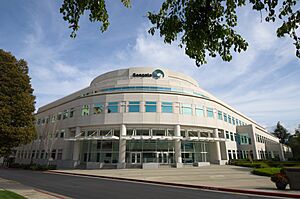

Seagate was first traded as a public company on the Nasdaq stock exchange. Its stock symbol was SGAT. In 1994, it moved to the New York Stock Exchange as SEG. In 2000, Seagate set up its legal base in the Cayman Islands. This was done to reduce income taxes.
In 2000, an investment group bought the company. This group included Seagate management, Silver Lake Partners, Texas Pacific Group, and others. This was part of a three-way merger and spin-off with Veritas Software. Veritas merged with Seagate, which was then bought by the investment group. Veritas was then immediately separated from Seagate. Veritas gained rights to Seagate Software Network and Storage Management Group. This included products like Backup Exec. It also gained Seagate's shares in SanDisk and Dragon Systems. Seagate Software Information Management Group was renamed Crystal Decisions in May 2001. In December 2002, Seagate became a public company again on the Nasdaq, with the symbol STX.
By November 2023, large investment groups owned 89% of Seagate's stock. Eight investors held a controlling share of 52%. The largest shares were held by Vanguard Group, Inc, Sanders Capital, LLC, and BlackRock, Inc. They owned 11%, 7.2%, and 7.2% of the shares, respectively.
Partnerships and Acquisitions
Finis Conner left Seagate in early 1985. He then started Conner Peripherals. This company first focused on small hard drives for portable computers. Conner Peripherals also started making tape drives when it bought Archive Corporation. After ten years as its own company, Seagate bought Conner Peripherals in a merger in 1996.
In 2005, Seagate bought Mirra Inc. This company made personal servers for data recovery. Seagate also bought ActionFront Data Recovery Labs, which helps people get back lost data.
In 2006, Seagate bought Maxtor in a deal worth $1.9 billion. After that, Seagate continued to sell products under the Maxtor brand name. The next year, Seagate bought EVault and MetaLINCS. These companies were later renamed i365.
In 2014, Seagate bought Xyratex. This was a company that made storage systems. The deal was for about $375 million. In the same year, Seagate bought LSI's flash enterprise PCIe flash and SSD controller products. It also bought their engineering teams from Avago for $450 million.
In October 2015, Seagate bought Dot Hill Systems. This company supplied software and hardware storage systems. The purchase was for about $696 million.



